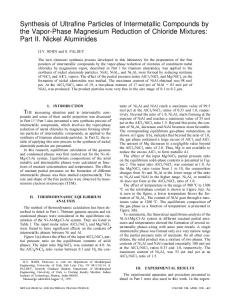Synthesis and nitrogen stability of ultrafine titanium carbonitride particles
- PDF / 227,938 Bytes
- 5 Pages / 612 x 792 pts (letter) Page_size
- 33 Downloads / 384 Views
Jae-Hwan Ahn and Hyungsik Chung Division of Chemical & Materials Engineering, Ajou University, Suwon, Kyoungki 443-749, Korea (Received 25 July 2006; accepted 12 October 2006)
The ultrafine titanium carbonitride particles (TiC0.5N0.5) with 100 nm in mean size was successfully synthesized by nitridation treatment at ordinary temperatures, 1373∼1473 K of the nanostructured half-stoichiometric titanium carbide (TiC0.5) particles, which were produced by the magnesium reduction of gaseous TiCl4+1/4C2Cl4. In addition, the nitrogen stability for the produced titanium carbonitride particles at various temperatures and vacuum conditions was investigated experimentally and compared with values calculated by an ideal solution model.
I. INTRODUCTION
Titanium carbonitride powders have been widely used as the raw materials for production of various ceramic tools.1–4 And it is well known that the initial particles, which are as fine as possible, can increase the hardness and toughness in the consolidated tool materials. Therefore, the research for titanium carbonitride materials has usually concentrated on the production of fine initial powders. Including the already commercialized carbothermal reduction method,5,6 several processes have been proposed for the production of TiCN powders such as the direct solid reaction of TiC with TiN or Ti with C, N,7,8 the self propagating high-temperature synthesis (SHS),9 the gaseous phase reaction,10 the liquid phase reaction such as the sol-gel process, and so on.11 However, these processes have at least one or more of the following drawbacks: (i) coarse particle formation owing to a very high temperature reaction (2073 K∼ 2273 K), (ii) easy oxidation during the process resulting in formation of TiCxOy, (iii) high free carbon content and contamination, in particular, during the milling process, and (iv) need for initial titanium powder of high purity. In our previous work, the simple approach to produce nanostructured TiCN particles using the metallothermic reduction process was introduced.12,13 This preparation process includes the following steps: (i) reaction of a solution of liquid metal chlorides (TiCl4 + 1⁄4C2Cl4) with sublimate magnesium nitride (Mg3N2), (ii) formation of the fine titanium carbonitride (TiC0.5N0.5) particles by a)
Address all correspondence to this author. e-mail: [email protected] DOI: 10.1557/JMR.2007.0024 J. Mater. Res., Vol. 22, No. 1, Jan 2007
http://journals.cambridge.org
Downloaded: 15 Mar 2015
the reaction of the titanium and carbon released from chloride reduction of magnesium dissociated from Mg3N2 and the identical nitridation dissociated nitrogen from magnesium nitride, and (iii) removal of the secondary phases of liquid MgCl2 and excess Mg3N2 by a vacuum heat treatment. In that process, however, it was not easy to completely remove the solid phase of magnesium nitrides by a vacuum treatment, resulting in significant amounts of magnesium oxide as an impurity inside of the TiCN products. Moreover, because the carburization and nitridation rea
Data Loading...










